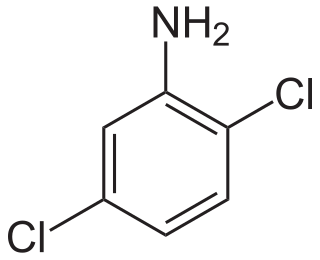
Aromatic compounds or arenes usually refers to organic compounds "with a chemistry typified by benzene" and "cyclically conjugated." The word "aromatic" originates from the past grouping of molecules based on odor, before their general chemical properties were understood. The current definition of aromatic compounds does not have any relation to their odor. Aromatic compounds are now defined as cyclic compounds satisfying Hückel's Rule. Aromatic compounds have the following general properties:

Biodegradation is the breakdown of organic matter by microorganisms, such as bacteria and fungi. It is generally assumed to be a natural process, which differentiates it from composting. Composting is a human-driven process in which biodegradation occurs under a specific set of circumstances.
Methyl violet is a family of organic compounds that are mainly used as dyes. Depending on the number of attached methyl groups, the color of the dye can be altered. Its main use is as a purple dye for textiles and to give deep violet colors in paint and ink. It is also used as a hydration indicator for silica gel. Methyl violet 10B is also known as crystal violet and has medical uses.

Bioremediation broadly refers to any process wherein a biological system, living or dead, is employed for removing environmental pollutants from air, water, soil, flue gasses, industrial effluents etc., in natural or artificial settings. The natural ability of organisms to adsorb, accumulate, and degrade common and emerging pollutants has attracted the use of biological resources in treatment of contaminated environment. In comparison to conventional physicochemical treatment methods bioremediation may offer advantages as it aims to be sustainable, eco-friendly, cheap, and scalable.
In organochlorine chemistry, reductive dechlorination describes any chemical reaction which cleaves the covalent bond between carbon and chlorine via reductants, to release chloride ions. Many modalities have been implemented, depending on the application. Reductive dechlorination is often applied to remediation of chlorinated pesticides or dry cleaning solvents. It is also used occasionally in the synthesis of organic compounds, e.g. as pharmaceuticals.

Nonylphenols are a family of closely related organic compounds composed of phenol bearing a 9 carbon-tail. Nonylphenols can come in numerous structures, all of which may be considered alkylphenols. They are used in manufacturing antioxidants, lubricating oil additives, laundry and dish detergents, emulsifiers, and solubilizers. They are used extensively in epoxy formulation in North America but its use has been phased out in Europe. These compounds are also precursors to the commercially important non-ionic surfactants alkylphenol ethoxylates and nonylphenol ethoxylates, which are used in detergents, paints, pesticides, personal care products, and plastics. Nonylphenol has attracted attention due to its prevalence in the environment and its potential role as an endocrine disruptor and xenoestrogen, due to its ability to act with estrogen-like activity. The estrogenicity and biodegradation heavily depends on the branching of the nonyl sidechain. Nonylphenol has been found to act as an agonist of the GPER (GPR30).
Cometabolism is defined as the simultaneous degradation of two compounds, in which the degradation of the second compound depends on the presence of the first compound. This is in contrast to simultaneous catabolism, where each substrate is catabolized concomitantly by different enzymes. Cometabolism occurs when an enzyme produced by an organism to catalyze the degradation of its growth-substrate to derive energy and carbon from it is also capable of degrading additional compounds. The fortuitous degradation of these additional compounds does not support the growth of the bacteria, and some of these compounds can even be toxic in certain concentrations to the bacteria.

Triclocarban is an antibacterial chemical once common in, but now phased out of, personal care products like soaps and lotions. It was originally developed for the medical field. Although the mode of action is unknown, TCC can be effective in fighting infections by targeting the growth of bacteria such as Staphylococcus aureus. Additional research seeks to understand its potential for causing antibacterial resistance and its effects on organismal and environmental health.
Organobromine chemistry is the study of the synthesis and properties of organobromine compounds, also called organobromides, which are organic compounds that contain carbon bonded to bromine. The most pervasive is the naturally produced bromomethane.

Diethyl phthalate (DEP) is a phthalate ester. It occurs as a colourless liquid without significant odour but has a bitter, disagreeable taste. It is more dense than water and insoluble in water; hence, it sinks in water.
Chlorinated polycyclic aromatic hydrocarbons (Cl-PAHs) are a group of compounds comprising polycyclic aromatic hydrocarbons with two or more aromatic rings and one or more chlorine atoms attached to the ring system. Cl-PAHs can be divided into two groups: chloro-substituted PAHs, which have one or more hydrogen atoms substituted by a chlorine atom, and chloro-added Cl-PAHs, which have two or more chlorine atoms added to the molecule. They are products of incomplete combustion of organic materials. They have many congeners, and the occurrences and toxicities of the congeners differ. Cl-PAHs are hydrophobic compounds and their persistence within ecosystems is due to their low water solubility. They are structurally similar to other halogenated hydrocarbons such as polychlorinated dibenzo-p-dioxins (PCDDs), dibenzofurans (PCDFs), and polychlorinated biphenyls (PCBs). Cl-PAHs in the environment are strongly susceptible to the effects of gas/particle partitioning, seasonal sources, and climatic conditions.

1,3,5-Trichlorobenzene is an organochlorine compound. It is one of the three isomers of trichlorobenzene. Being more symmetrical than the other isomers, it exists as colourless crystals whereas the other isomers are liquids at room temperature.
Carbocatalysis is a form of catalysis that uses heterogeneous carbon materials for the transformation or synthesis of organic or inorganic substrates. The catalysts are characterized by their high surface areas, surface functionality, and large, aromatic basal planes. Carbocatalysis can be distinguishable from supported catalysis in that no metal is present, or if metals are present they are not the active species.

1,4-Dichloro-2-nitrobenzene is an organic compound with the formula C6H3Cl2NO2. One of several isomers of dichloronitrobenzene, it is a yellow solid that is insoluble in water. It is produced by nitration of 1,4-dichlorobenzene. It is a precursor to many derivatives of commercial interest. Hydrogenation gives 1,4-dichloroaniline. Nucleophiles displace the chloride adjacent to the nitro group: ammonia gives the aniline derivative, aqueous base gives the phenol derivative, and methoxide gives the anisole derivative. These compounds are respectively 4-chloro-2-nitroaniline, 4-chloro-2-nitrophenol, and 4-chloro-2-nitroanisole.

Dichloroanilines are chemical compounds which consist of an aniline ring substituted with two chlorine atoms and have the molecular formula C6H5Cl2N. There are six isomers, varying in the positions of the chlorine atoms around the ring relative to the amino group. As aniline derivatives, they are named with the amino group in position 1. They are all colorless, although commercial samples can appear colored due to the presence of impurities. Several derivatives are used in the production of dyes and herbicides.

3,5-Lutidine is a heterocyclic organic compound with the formula (CH3)2C5H3N. It is one of several dimethyl-substituted derivatives of pyridine, all of which are referred to as lutidines. It is a colorless liquid with mildly basic properties and a pungent odor. The compound is a precursor to the drug omeprazole.
4-Fluoronitrobenzene is an organic compound with the formula FC6H4NO2. It is one of three isomeric fluoronitrobenzenes. A yellow oil, it is prepared from 4-nitrochlorobenzene using the Halex process:
4-Fluoroaniline is an organofluorine compound with the formula FC6H4NH2. A colorless liquid, it is one of three isomers of fluoroaniline. It is used as a precursor to various potential and real applications.
3,4-Dichloroaniline is an organic compound with the formula C6H3Cl2(NH2). It is one of several isomers of dichloroaniline. It is a white solid although commercial samples often appear gray. It is a precursor to dyes, agricultural chemicals, and drugs including the antimalarial chlorproguanil and the herbicides propanil, linuron, DCMU, and diuron.

2,3-Dichloroaniline is an organic compound with the formula C6H3Cl2(NH2). It is one of several isomers of dichloroaniline. It is a colorless oil although commercial samples often appear colored. It is produced by hydrogenation of 2,3-dichloronitrobenzene.














